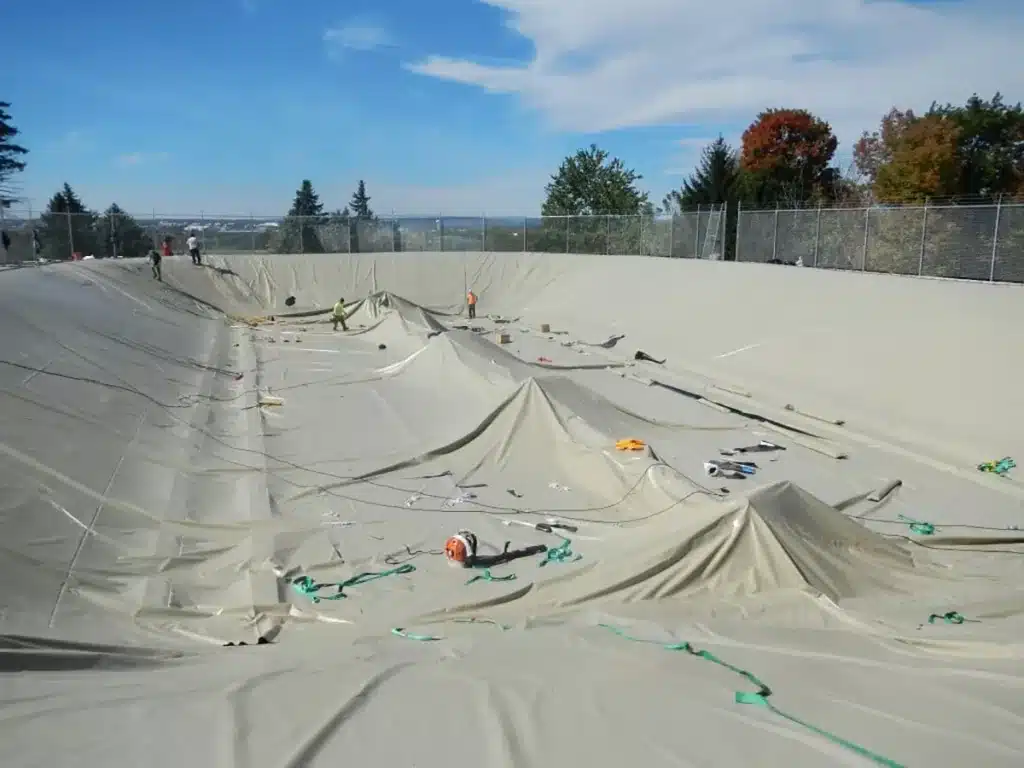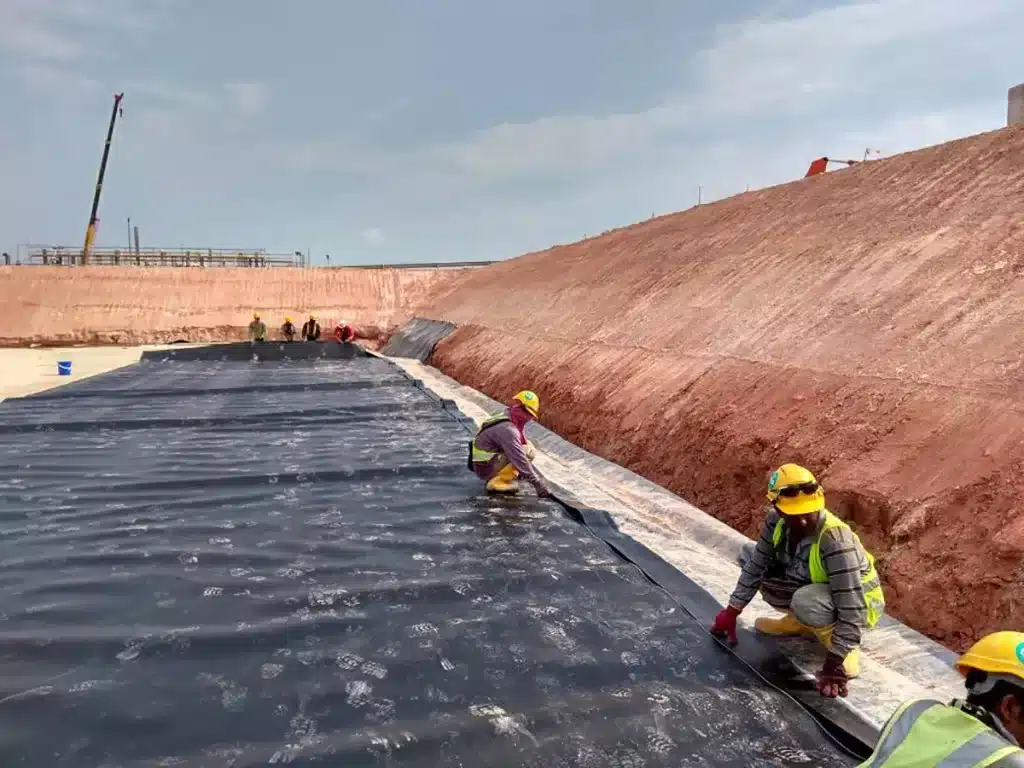+86-159 9860 6917
info@geofantex.com
geofantex@gmail.com
+86-400-8266163-44899
Water-permeable, geotextile, or geosynthetic membranes are generally used for separation, filtration, reinforcement as well as protection around the house and garden. On a larger scale, it is also used in civil engineering works to create roads, parking lots, railways, and many other things. BigMat provides you with all the equipment useful for water evacuation and treatment in its network of stores in Belgium. Receive or consult our PDF catalog Request your quote online

The different models of geotextile
Overview of Geotextiles
Geotextiles are permeable fabrics used in conjunction with soil to enhance stability, provide erosion control, and facilitate drainage. They are commonly used in construction and environmental projects. Here is a detailed overview of the different types of geotextiles and their applications:
Types of Geotextiles
- Characteristics: Made from weaving together yarns or fibers, providing high tensile strength.
- Benefits: Durable, strong, and resistant to deformation.
- Applications: Ideal for soil stabilization, erosion control, and reinforcement in road construction.
- Characteristics: Manufactured from bonding fibers together using chemical, mechanical, or thermal processes.
- Benefits: Highly effective in filtration and drainage applications.
- Applications: Used for separation, filtration, drainage, and protection purposes.
Knitted Geotextiles
- Characteristics: Created using knitting techniques, providing flexibility and strength.
- Benefits: Combines the strengths of woven and non-woven geotextiles.
- Applications: Suitable for reinforcement and separation in various construction projects.
Applications of Geotextiles
Road Construction
- Use: Reinforce the soil, improve load distribution, and prevent soil erosion.
- Types Used: Woven and non-woven geotextiles.
- Benefits: Enhances the longevity and durability of roads.
Erosion Control
- Use: Stabilize slopes, shorelines, and riverbanks to prevent soil erosion.
- Types Used: Woven and non-woven geotextiles.
- Benefits: Protects infrastructure and the environment from erosion.
Drainage Systems
- Use: Facilitate the movement of water in drainage systems.
- Types Used: Non-woven geotextiles.
- Benefits: Prevents soil clogging while allowing water to pass through.
Landfills
- Use: Act as a barrier to prevent contamination of soil and groundwater.
- Types Used: Non-woven geotextiles.
- Benefits: Enhances the safety and efficiency of landfill operations.
Agriculture
- Use: Improve soil stability and prevent weed growth.
- Types Used: Both woven and non-woven geotextiles.
- Benefits: Increases crop yield and soil quality.
Environmental Projects
- Use: Support ecological restoration and habitat creation.
- Types Used: Varies based on the project requirements.
- Benefits: Promotes sustainable development and environmental conservation.
Geotextiles are versatile materials with a wide range of applications in construction and environmental projects. Their various types—woven, non-woven, and knitted—offer unique benefits that make them suitable for specific tasks such as soil stabilization, erosion control, drainage, and environmental protection. Understanding the characteristics and applications of each type can help in selecting the right geotextile for a given project, ensuring efficiency and effectiveness.
The main functions of geotextiles
Geotextiles are versatile materials used in construction and civil engineering projects for a variety of purposes. Their main functions include:
- Separation: Geotextiles are used to separate different layers of soil to prevent them from mixing. This is essential in road construction, where a layer of geotextile is placed between the subgrade and the base material to maintain the integrity and performance of the road structure.
- Reinforcement: Geotextiles provide reinforcement to soil and other construction materials, enhancing their strength and stability. This function is crucial in the construction of retaining walls, embankments, and slopes, where the geotextile helps to distribute loads and reduce the risk of structural failure.
- Filtration: Geotextiles act as filters, allowing water to pass through while preventing soil particles from being washed away. This function is important in drainage systems, where the geotextile prevents clogging of drainage pipes and maintains efficient water flow.
- Drainage: By facilitating the movement of water within the soil, geotextiles help to control moisture levels and prevent waterlogging. This function is vital in applications such as landfills, where geotextiles ensure proper leachate drainage, and in road construction, where they prevent the accumulation of water that can weaken the road structure.
- Protection: Geotextiles protect other construction materials, such as geomembranes, from damage. In landfill and pond linings, for example, geotextiles are placed over geomembranes to prevent punctures and tears caused by sharp objects or heavy loads.
Importance in Infrastructure Projects:
- Durability: Geotextiles enhance the longevity of infrastructure projects by preventing soil erosion, maintaining soil stability, and ensuring proper drainage.
- Cost-Effectiveness: By improving the performance and durability of construction materials, geotextiles help to reduce maintenance costs and extend the lifespan of infrastructure.
- Environmental Benefits: Geotextiles contribute to sustainable construction practices by reducing soil erosion, promoting efficient water management, and minimizing the impact on natural resources.
Examples of work that can be carried out using geosynthetic membranes
Construction Applications:
- Roadways and Highways: Geosynthetic membranes are used for subgrade stabilization, improving the load-bearing capacity of the soil and preventing rutting and cracking of the road surface.
- Foundations and Basements: These membranes serve as barriers to prevent water infiltration, ensuring dry and stable foundations.
- Retaining Walls: They provide reinforcement and drainage, enhancing the stability and longevity of retaining structures.
Environmental Protection:
- Landfills: Geosynthetic membranes are essential in lining systems to prevent leachate contamination of groundwater and surrounding soil.
- Wastewater Treatment: Used in the construction of lagoons and ponds, they ensure containment and prevent leakage of treated or untreated wastewater.
- Erosion Control: These membranes help in stabilizing slopes and riverbanks, reducing soil erosion and promoting vegetation growth.
Water Management:
- Reservoirs and Dams: Geosynthetic liners are used to prevent seepage and loss of stored water, ensuring efficient water management.
- Canals and Irrigation Systems: They help in reducing water loss through seepage, thereby enhancing the efficiency of irrigation systems.
- Stormwater Management: Membranes are used in detention ponds and drainage systems to manage and control stormwater runoff.
Mining Industry:
- Heap Leach Pads: Geosynthetic membranes are used to line heap leach pads, preventing the escape of harmful chemicals into the environment.
- Tailings Ponds: They provide secure containment for mine tailings, reducing the risk of environmental contamination.
Agriculture:
- Agricultural Ponds: These membranes are used to line ponds for irrigation and aquaculture, ensuring water conservation and quality.
- Silage Covers: They protect stored forage from weather elements, maintaining its nutritional value.

Do you want to undertake a project in complete safety using geotextiles?
- Project Scope and Objectives: Define the scope of the project and the specific areas where geotextiles will be utilized. Establish clear objectives focused on safety, stability, and durability.
- Material Selection: Research and select the appropriate type of geotextile based on project requirements (e.g., non-woven, woven, or knitted). Consider factors such as soil type, environmental conditions, and load-bearing capacity.
- Design and Engineering: Collaborate with civil engineers to integrate geotextiles into the project design. Conduct thorough site assessments to determine the best application methods.
- Installation Plan: Develop a detailed installation plan, including timelines, equipment needed, and workforce requirements. Ensure all safety protocols and regulations are strictly followed during installation.
- Quality Control and Testing: Implement a robust quality control process to test the effectiveness of the geotextile. Conduct regular inspections and monitoring to ensure long-term performance and safety.
- Maintenance and Monitoring: Establish a maintenance schedule to check the condition of geotextiles and perform necessary repairs. Monitor the site regularly to detect any issues early and address them promptly.
Get Free Sample
We’ll respond as soon as possible(within 12 hours)





















